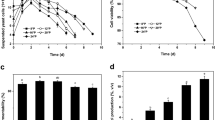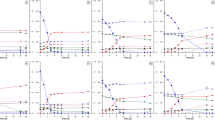Summary
Very high gravity (VHG) worts of 24° Plato supplemented with various amounts of yeast extract (YE) were inoculated at two different levels with a commercial lager strain ofSaccharomyces cerevisiae, and the resultant beers and yeast crops were analyzed. Excess assimilable nitrogen did not result in higher viable yeast counts but did lead to increased rates of growth and increased accumulation of cell mass (partly due to higher cellular protein content). Fermentation (ethanol production) rates were significantly enhanced by YE supplementation up to 1.25% w/v, and the maximum ethanol concentrations seen were significantly higher as YE levels were increased (maximum effect at 0.75%), although YE itself was largely unfermentable. Lower ethanol yields in unsupplemented control worts could not be explained by increased carbon diversion to acetaldehyde, glycerol, or glycogen.
Similar content being viewed by others
References
Agenbach, W.A. 1977. A study of must nitrogen content in relation to incomplete fermentations, yeast production and fermentation activity. Proc. South African Soc. Enol. Vitic. p. 66–87.
Casey, G.P., C.A. Magnus and W.M. Ingledew. 1984. Highgravity brewing: Effects of nutrition on yeast composition, fermentative ability, and alcohol production. Appl. Environ. Microbiol. 48: 639–646.
Casey, G.P. and W.M. Ingledew. 1985. Reevaluation of alcohol synthesis and tolerance in brewer's yeast. J. Am. Soc. Brew. Chem. 43: 75–83.
Chen, S.L. 1981. Optimization of batch alcoholic fermentation of glucose syrup substrate. Biotechnol. Bioeng. 23: 1827–1836.
European Brewery Convention. 1987. Free amino nitrogen. Analytica-EBC. (4th edn.) pp. E141–142.
Ingledew, W.M., F.W. Sosulski and C.A. Magnus. 1986. An assessment of yeast foods and their utility in brewing and enology. J. Am. Soc. Brew. Chem. 44: 166–170.
Ingledew, W.M., J.D. Burton, D.W. Hysert and G. Van Gheluwe. 1980. Membrane filtration: Survival of brewing microbes on the membrane during storage at reduced humidities. J. Am. Soc. Brew. Chem. 38: 125–129.
Ingledew, W.M. and R.E. Kunkee. 1985. Factors influencing sluggish fermentations of grape juice. Am. J. Enol. Vitic. 36: 65–76.
Jones, M.O. and C. Rainbow. 1966. Simple methods of determining major nitrogenous compounds in worts and beers. Am. Soc. Brew. Chem. Proc. pp. 66–70.
Kirsop, B.H. 1971. Yeast metabolism and sugar utilization. Brew. Guard. 56–58.
Kirsop, B.H. 1977. Yeast lipids and beer flavour. M.B.A.A. Tech. Quart. 14: 227–230.
Knudsen, F.B. 1985. Fermentation variables and their control. J. Am. Soc. Brew. Chem. 43: 91–95.
Lowry, O.H., N.J. Rosebrough, A.L. Farr, and R.J. Randall. 1951. Protein measurement with the Folin phenol reagent. J. Biol. Chem. 193: 267–275.
Lyons, T.P. 1981. Distillery fermentations. In: A Step to Energy Independence (T.P. Lyons, ed.), pp. 85–111, Alltech Technical Publications, Lexington, KY.
Monk, P.R., D. Hook and B.M. Freeman, 1986. Amino acid metabolism by yeast. Proc. 6th Austral. Wine Ind. Tech. Conf. July 14–17, Adelaide, pp. 129–133.
Nursten, H.E. 1981. Recent developments in studies of the Maillard reaction. Food Chem. 6: 263–277.
O'Connor-Cox, E.S.C. and W.M. Ingledew. 1990. Wort nitrogenous sources-their use by brewing yeasts: a review. J. Am. Soc. Brew. Chem. 47: 102–108.
O'Connor-Cox, E.S.C. and W.M. Ingledew. 1991. Allevation of the effects of nitrogen limitation in high gravity worts throug increased inoculation rates. J. Indust. Microbiol. 7: 89–96.
Pickerell, A.T.W. 1986. The influence of free alpha-amino nitrogen in sorghum beer fermentations. J. Inst. Brew. 92: 568–571.
Pierce, J.S. 1987. The role of nitrogen in brewing. J. Inst. Brew. 93: 378–381.
Quain, D.E., P.A. Thurston and R.S. Tubb. 1981. The structural and storage carbohydrates ofSaccharomyces cerevisiae: changes during fermentation of wort and a role for glycogen metabolism in lipid biosynthesis. J. Inst. Brew. 87: 108–111.
Quain, D.E. and R.S. Tubb. 1983. A rapid and simple method for the determination of glycogen in yeast. J. Inst. Brew. 89: 38–40.
Saita, M. and J.C. Slaughter. 1984. Acceleration of the rate of fermentation bySaccharomyces cerevisiae in the presence of ammonium ion. Enz. Microb. Technol. 6: 375–378.
Thomas, K.C. and W.M. Ingledew. 1990. Fuel alcohol production: Effects of free amino nitrogen on fermentation of very-high-gravity wheat mashes. Appl. Environ. Microbiol. 56: 2046–2050.
Vos, P.J.A., E. Crous and L. Swart. 1980. Fermentation and the optimal nitrogen balance of musts. Wynboer. Maart. 582: 58–62.
Vos, P.J.A. and R.S. Gray. 1979. The origin and control of hydrogen sulfide during fermentation of grape must. Am. J. Enol. Vitic. 30: 187–197.
Author information
Authors and Affiliations
Rights and permissions
About this article
Cite this article
O'Connor-Cox, E.S.C., Paik, J. & Ingledew, W.M. Improved ethanol yields through supplementation with excess assimilable nitrogen. Journal of Industrial Microbiology 8, 45–52 (1991). https://doi.org/10.1007/BF01575590
Received:
Revised:
Accepted:
Issue Date:
DOI: https://doi.org/10.1007/BF01575590




